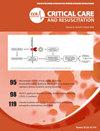重症监护病房获得性高钠血症:患病率、危险因素、发展轨迹、管理和结果。
IF 1.4
4区 医学
Q3 CRITICAL CARE MEDICINE
引用次数: 0
摘要
背景:重症监护病房获得性高钠血症(ICU-AH)是危重症的严重并发症。然而,没有关于这种情况如何发展的详细信息。目的:本研究的目的是研究重症ICU-AH(≥155 mmol·L-1)的患病率、危险因素、发展轨迹、管理和结局。方法:对某大学附属医院40张床位的ICU进行回顾性研究。评估钠水平、重症ICU-AH相关因素、尿电解质测量、水治疗、体液平衡、矫正率和谵妄。结果:我们筛选了11,642例ICU入院患者,确定了109例重症ICU- ah患者。中位年龄为57岁,63%为男性,急性生理和慢性健康评估III评分中位为64分(52分;80)。入院当天,64%的患者进行了通气;71%接受血管加压药物治疗,22%发生急性肾损伤。钠含量峰值中位数为158 (156;161) mmol -1,中位数为4 (1;入住ICU后11天。只有8例(7%)患者检测了尿钠(中位浓度:17 mmol·L-1)。高钠血症高峰当日,80%患者因有创通气无法饮水;34%的患者服用利尿剂;25%有发热,50%未接受低渗液。当可用时,无电解质水间隙的中位数为-1.1 L (-1.7;-0.5),占尿量的一半。在高峰高钠血症后,前3 d的纠正率为-2.8 mmol·L-1 /天(95%可信区间:[-2.9至-2.6])。结论:严重高钠血症发生在不能喝水、几乎没有尿游离水损失测量、利尿剂治疗、发烧、肾功能损害以及几乎没有或有限或延迟给水的情况下。修正是缓慢的。本文章由计算机程序翻译,如有差异,请以英文原文为准。
Severe intensive care unit–acquired hypernatraemia: Prevalence, risk factors, trajectory, management, and outcome
Background
Severe intensive care unit–acquired hypernatraemia (ICU-AH) is a serious complication of critical illness. However, there is no detailed information on how this condition develops.
Objectives
The objective of this study was to study the prevalence, risk factors, trajectory, management, and outcome of severe ICU-AH (≥155 mmol·L−1).
Methods
A retrospective study was conducted in a 40-bed ICU in a university-affiliated hospital. Assessment of sodium levels, factors associated with severe ICU-AH, urinary electrolyte measurements, water therapy, fluid balance, correction rate, and delirium was made.
Results
We screened 11,642 ICU admissions and identified 109 patients with severe ICU-AH. The median age was 57 years, 63% were male, and the median Acute Physiology and Chronic Health Evaluation III score was 64 (52; 80). On the day of ICU admission, 64% of patients were ventilated; 71% received vasopressors, and 22% had acute kidney injury. The median peak sodium level was 158 (156; 161) mmolL−1 at a median of 4 (1; 11) days after ICU admission. Only eight patients (7%) had urine sodium measurement (median concentration: 17 mmol·L−1). On the day of peak hypernatraemia, 80% of patients were unable to drink due to invasive ventilation; 34% were on diuretics; 25% had fever, and 50% did not receive hypotonic fluids. When available, the median electrolyte-free water clearance was −1.1 L (−1.7; −0.5), representing half of the urine output. After peak hypernatraemia, the correction rate was −2.8 mmol·L−1 per day (95% confidence interval: [-2.9 to −2.6]) during the first 3 d.
Conclusions
Severe hypernatraemia occurred in the setting of inability to drink, near-absent measurement of urinary free water losses, diuretic therapy, fever, renal impairment, and near-absent or limited or delayed water administration. Correction was slow.
求助全文
通过发布文献求助,成功后即可免费获取论文全文。
去求助
来源期刊

Critical Care and Resuscitation
CRITICAL CARE MEDICINE-
CiteScore
7.70
自引率
3.40%
发文量
44
审稿时长
>12 weeks
期刊介绍:
ritical Care and Resuscitation (CC&R) is the official scientific journal of the College of Intensive Care Medicine (CICM). The Journal is a quarterly publication (ISSN 1441-2772) with original articles of scientific and clinical interest in the specialities of Critical Care, Intensive Care, Anaesthesia, Emergency Medicine and related disciplines.
The Journal is received by all Fellows and trainees, along with an increasing number of subscribers from around the world.
The CC&R Journal currently has an impact factor of 3.3, placing it in 8th position in world critical care journals and in first position in the world outside the USA and Europe.
 求助内容:
求助内容: 应助结果提醒方式:
应助结果提醒方式:


